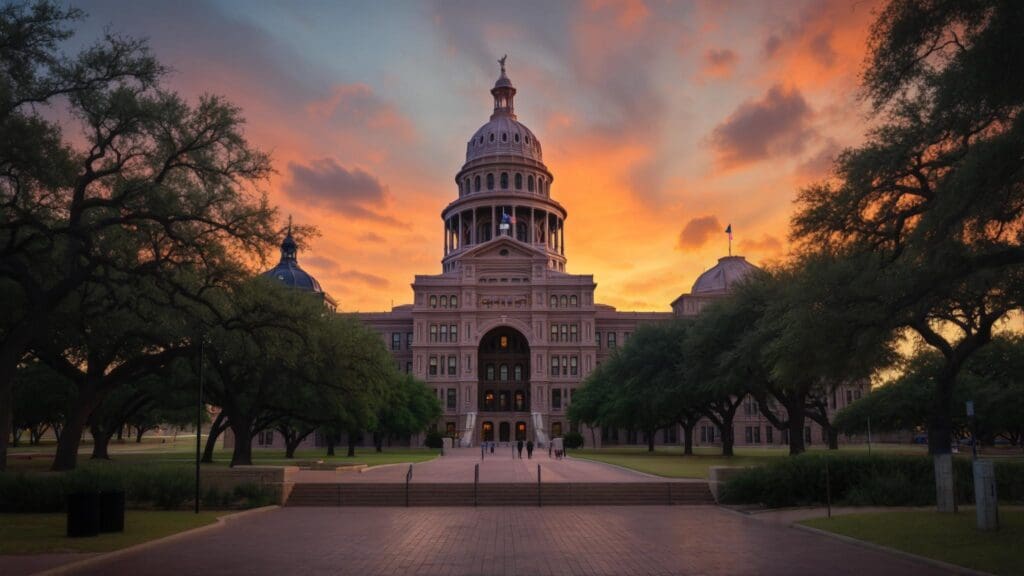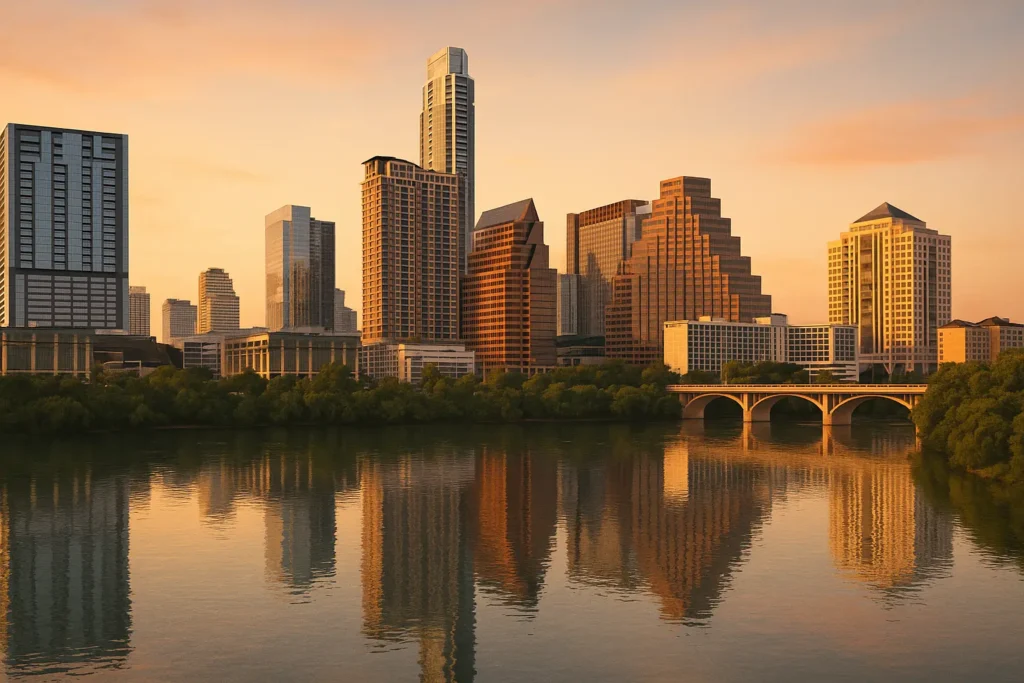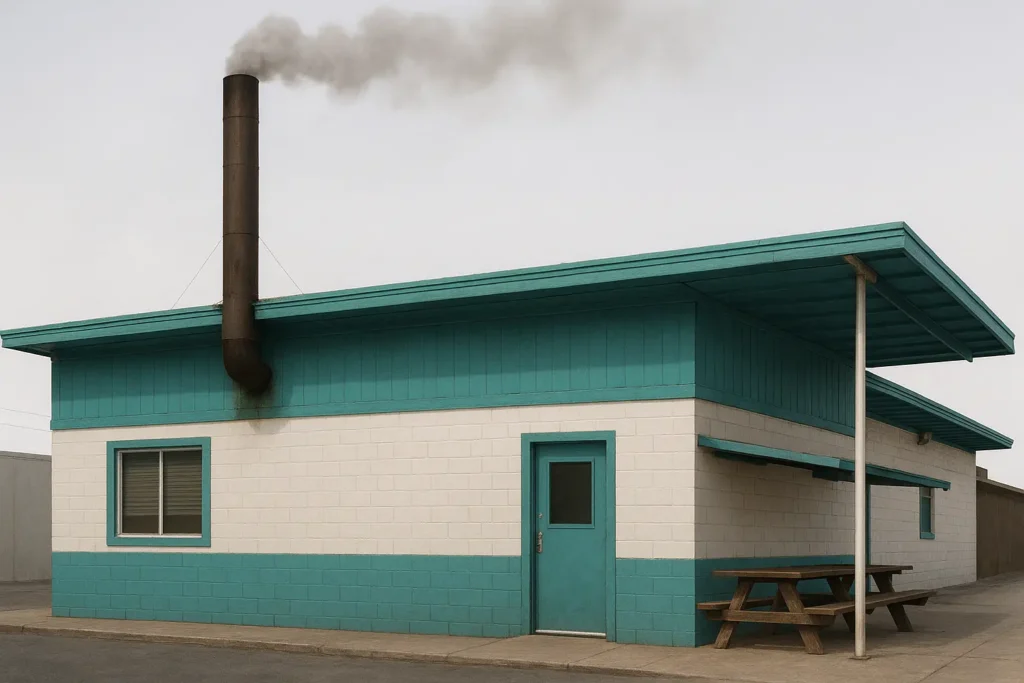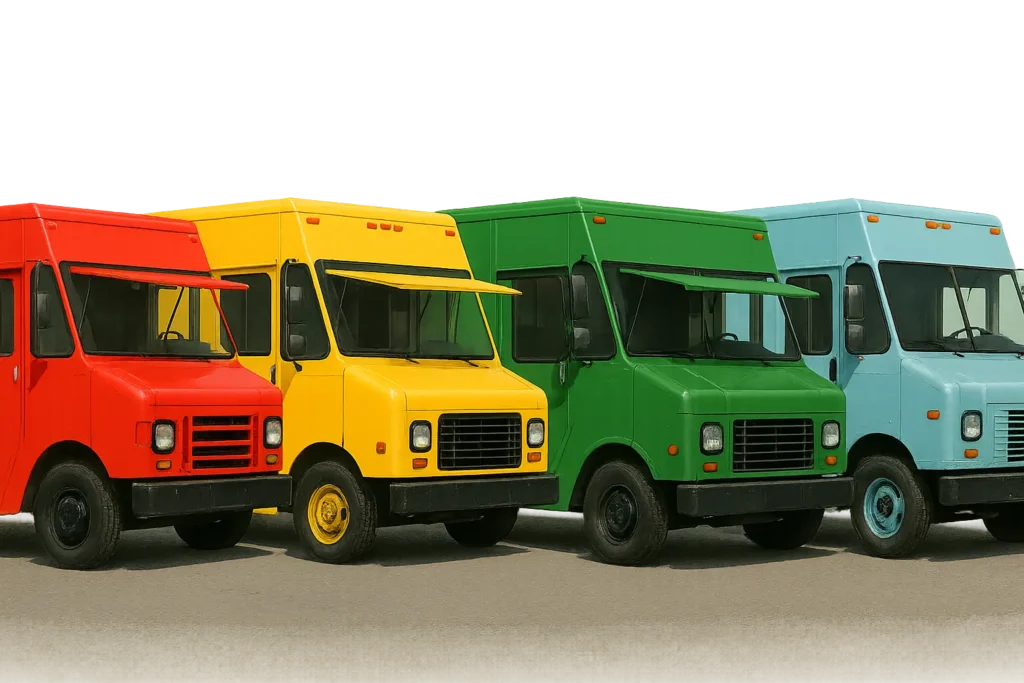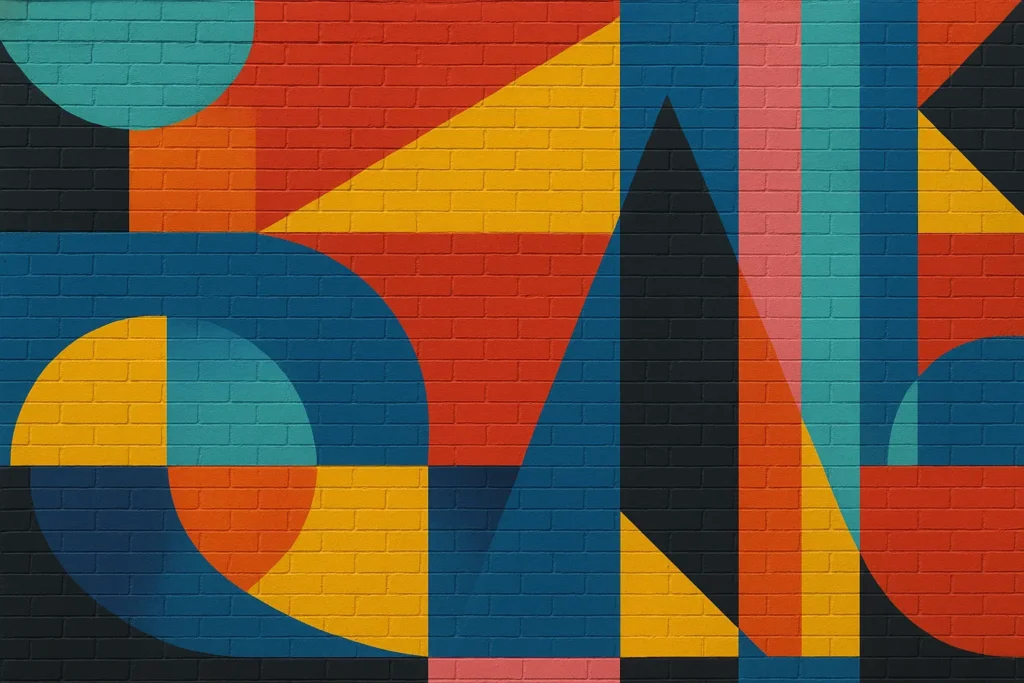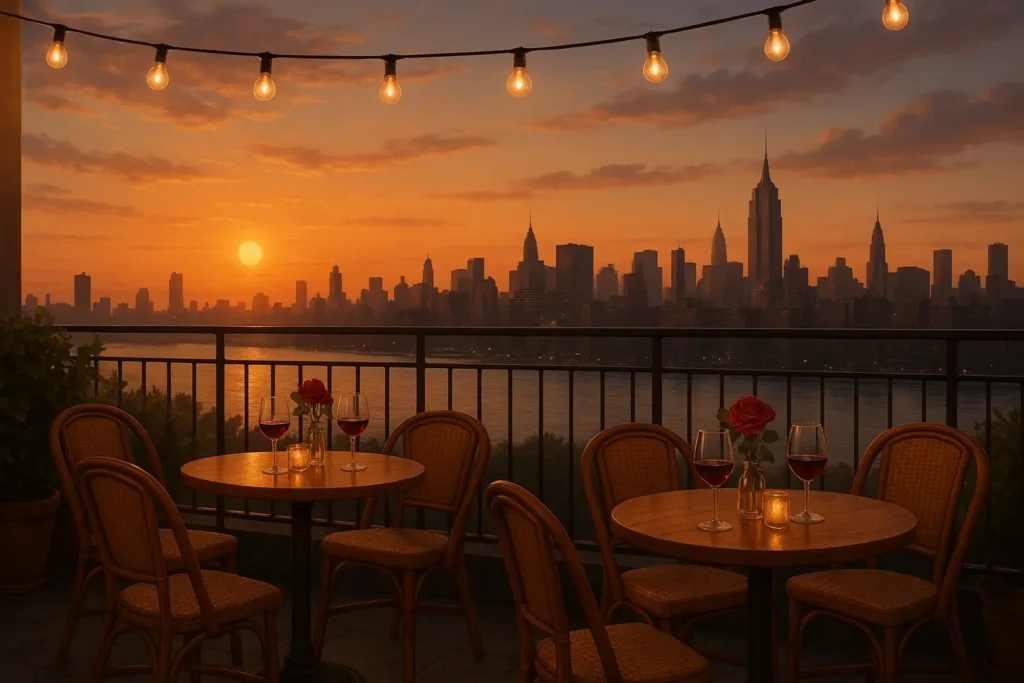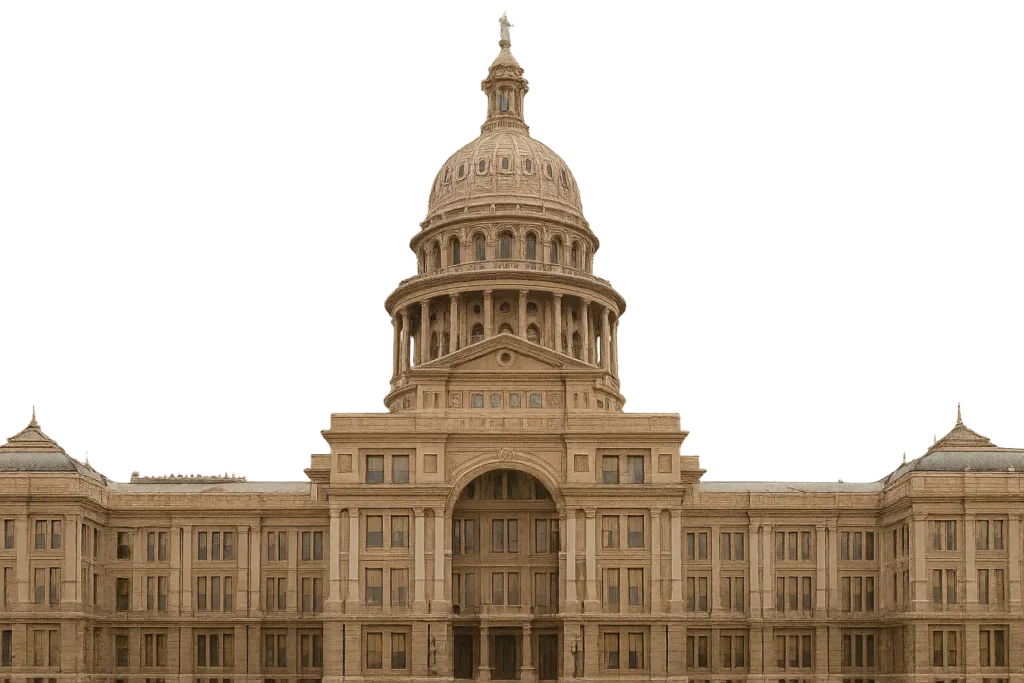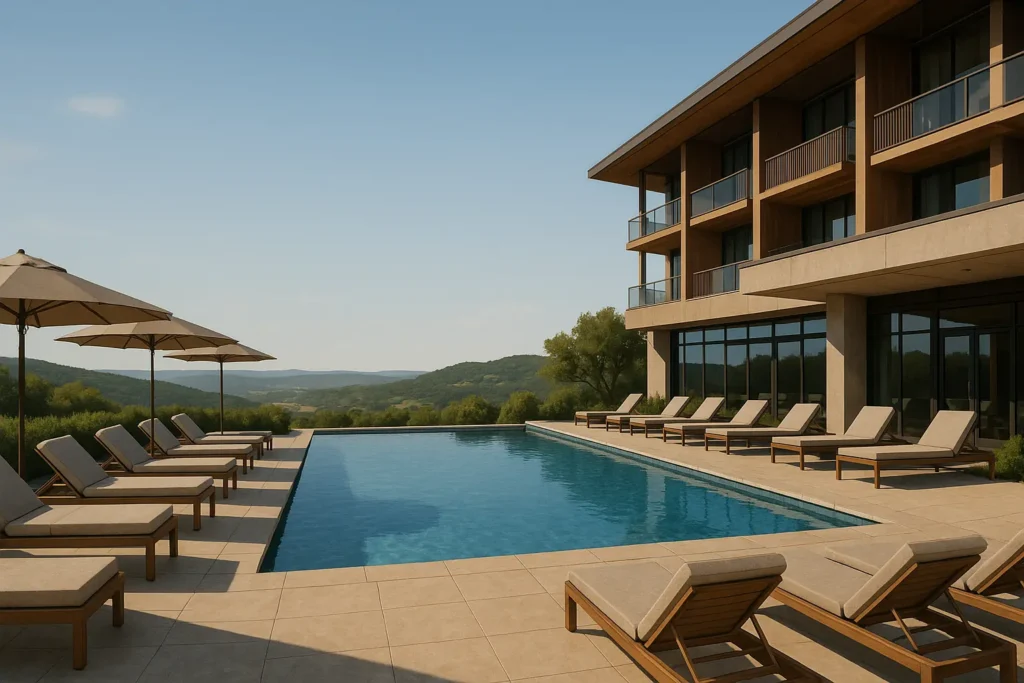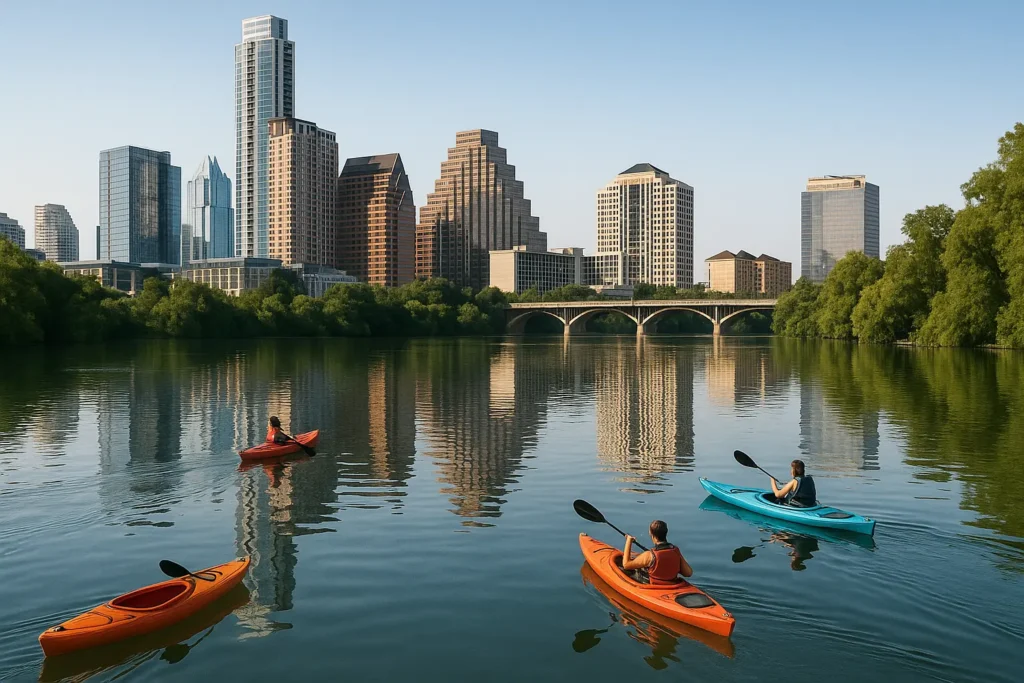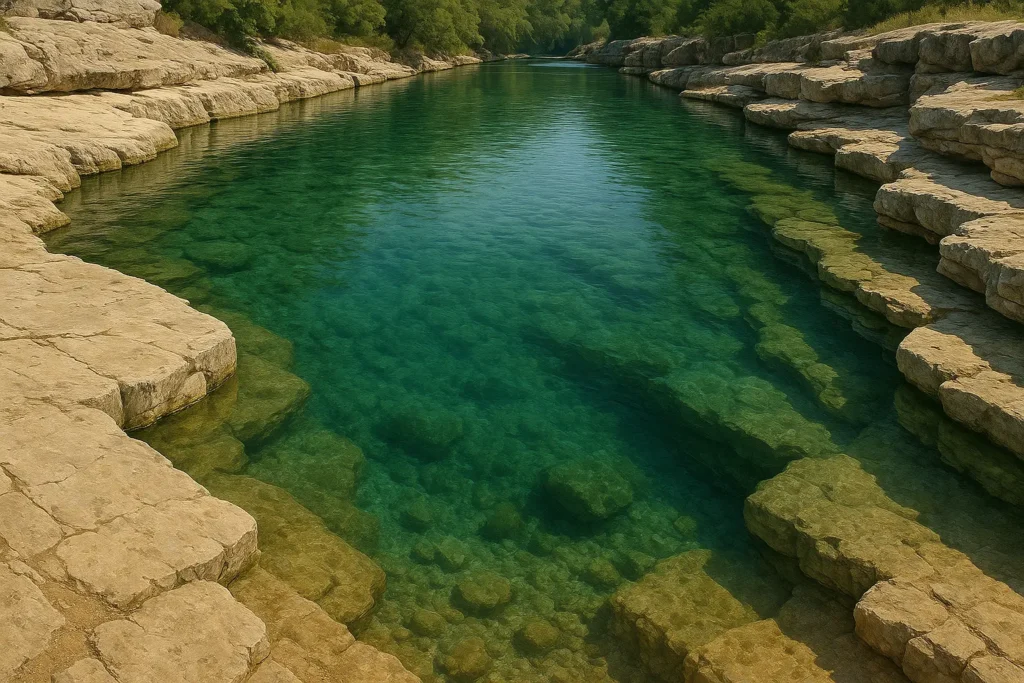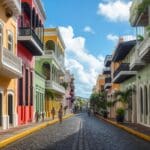I’ll be honest – I came to Austin for what I thought would be a quick weekend trip and ended up calling my boss to extend my vacation. Twice. There’s just something about this city that gets under your skin. Maybe it’s the way live music spills out of every doorway, or how you can get world-class BBQ from a food truck in a gas station parking lot, or the fact that swimming in 70-degree spring water when it’s 100 degrees outside feels like actual magic.
Austin consistently ranks as one of America’s best cities to visit according to national publications such as US News and World Report, Money Magazine, Kiplinger and Forbes, and after spending way more time here than I originally planned, I get why. The city’s got this perfect storm of live music, incredible food, and outdoor adventures that somehow all work together without feeling forced.
Use our Vacation Planner to build your perfect Austin trip
Quick Resources
Here’s the thing about planning an Austin trip – it can feel overwhelming because there’s just so much good stuff competing for your attention. You want to hit Franklin Barbecue and catch some live music, but you also don’t want to miss those hidden gems that make locals roll their eyes when tourists walk past them. Whether you’re planning a quick weekend or have a whole week to burn, having a game plan helps you actually enjoy yourself instead of running around stressed.
Start mapping your dream Austin itinerary with our Vacation Planner
I’m going to give you way too many options here – 25 different Austin itineraries across six categories – but don’t stress. Just pick what sounds fun and ignore the rest. You can’t see everything in one trip, and that’s okay. From budget adventures where you’re living off food trucks to luxury experiences where money’s no object, there’s an Austin itinerary that’ll work for you.
TL;DR
- Austin’s got 25 different ways to spend your time, from weekend hits to week-long deep dives
- Let’s be real about money – you can do this on $75-100/day if you’re smart, or blow $200+ if you want to live it up
- Timing matters big time – festival seasons mean crowds and premium prices, but also incredible experiences
- Downtown’s totally walkable, but you’ll need wheels to hit the Hill Country swimming holes
- Music, food, and outdoor stuff – that’s Austin’s holy trinity, no matter which itinerary you pick
- Group dynamics can make or break your trip – solo travelers have it easy, big groups need serious planning
- Summer in Austin is brutal – like, your phone overheats just sitting in your pocket brutal
What Makes Planning Austin Different From Anywhere Else
Austin isn’t your typical city trip, and that’s the point. The music scene doesn’t even get started until 10 PM, which means you’ll be eating dinner at 9 and wondering why everything seems dead at 8. Food trucks serve meals that’ll ruin you for fancy restaurants, and the best swimming holes are an hour outside the city but worth every minute of the drive.
The weather here plays by its own rules. Summer temperatures regularly hit 100°F+, which makes outdoor activities from noon to 7 PM basically torture. Spring brings perfect weather, but also SXSW crowds and hotel prices that’ll make you question your life choices. Fall’s your sweet spot – great weather, fewer crowds, and you can actually get dinner reservations without planning three weeks ahead.
Time your visit smart — try the Vacation Planner’s date & cost features
Here’s what nobody tells you: Austin’s neighborhoods feel like completely different cities. South Lamar is where you’ll blow your budget on vintage finds and craft cocktails. East Austin used to be sketchy, now it’s where you go for Instagram murals and $15 cocktails. And the Hill Country? That’s your Sunday drive with the windows down and nowhere important to be.
For group celebrations and special occasions, consider exploring our comprehensive Austin bachelorette party guide which complements many of these itinerary ideas perfectly.
Pair your Austin plans with the Elopement Planner for seamless event + trip coordination
Look, here’s the real deal on Austin neighborhoods: Downtown is where you’ll probably stay your first time – everything’s walkable and you can’t get too lost. South Lamar is where the cool kids hang out (and where you’ll spend way too much money at vintage shops). East Austin used to be sketchy, now it’s where you go for Instagram-worthy murals and $15 cocktails. The Hill Country? That’s your Sunday drive with the windows down and nowhere to be. Rainey Street’s where you go when you want to feel fancy but not stuffy, and 6th Street is… well, it’s exactly what you think it is.
| Austin Neighborhood | Best For | Time Needed | Transportation |
|---|---|---|---|
| Downtown/6th Street | Live music, nightlife, State Capitol | 1-2 days | Walking |
| South Austin/Lamar | Food trucks, vintage shopping, Zilker Park | 1-2 days | Car/rideshare |
| East Austin | Art galleries, craft breweries, trendy dining | 1 day | Car/rideshare |
| Rainey Street | Rooftop bars, upscale nightlife | Half day | Walking from downtown |
| Hill Country | Wineries, swimming holes, scenic drives | Full day | Car required |
Plan transportation and day trips via our Vacation Planner
Weekend Warrior Itineraries (2-3 Days)
Weekend trips to Austin are all about hitting the greatest hits without feeling like you’re running a marathon. These Austin itinerary plans focus on the stuff you absolutely can’t miss while leaving room to breathe and actually enjoy yourself. Fair warning though – you’ll probably want to come back for a longer trip once you get a taste of what this city’s really about.
1. Classic Austin Weekend
This is your Austin 101 – all the stuff people will ask you about when you get home. Day one starts downtown because that’s where Austin’s political heart beats. The State Capitol’s free tours are actually pretty cool (and air-conditioned), but the real test comes next: Franklin Barbecue. Yes, you’ll wait. Yes, it’s worth it. Pro tip – bring a cooler with beer, make friends with people in line, and embrace the fact that waiting for great BBQ is basically an Austin rite of passage.
After you’ve had your BBQ enlightenment, hit the Bullock Texas State History Museum. I know, I know – museums aren’t usually weekend priorities, but this one actually explains why Austin is the way it is. End your first day bar hopping on Rainey Street, where you can drink craft cocktails in converted houses and feel like you’re at someone’s really cool house party.
Day two is all about South Austin vibes. Start with breakfast tacos at Veracruz All Natural (get the migas, thank me later), then wander South Lamar’s vintage shops and record stores. You’ll spend more than you planned – just accept it. Barton Springs Pool is your afternoon salvation. This place is weird in the best way – it’s 70 degrees year-round, which feels like magic when it’s 100 degrees outside or surprisingly warm when it’s 50.
Your final morning should be East Austin coffee and culture. Radio Coffee & Beer serves excellent coffee and has this laid-back vibe that perfectly captures Austin’s “we’re cool but not trying too hard” energy. Walk around and check out the murals, grab lunch at East Side King, and congratulate yourself on experiencing Austin’s full personality spectrum in just three days.
2. Music Lover’s Weekend
If you came to Austin for the music, this Austin itinerary is your jam. Start with the Austin Music Walk of Fame downtown – it’s touristy but gives you context for what you’re about to experience. Lunch at Threadgill’s isn’t just about the food (though it’s good); this is where Janis Joplin got her start, and you can feel the history in the walls.
Spend your afternoon record shopping at Antone’s and Waterloo Records. The staff at both places know their stuff and aren’t snobby about it. They’ll point you toward local bands you’ve never heard of that’ll become your new obsession. Evening at The Continental Club is non-negotiable – this place has been hosting live music since 1955, and it shows.
Day two is when things get real. The Red River Cultural District is basically several music venues within stumbling distance of each other. Start at Stubb’s Bar-B-Q for dinner and early shows, then venue-hop your way through the night. Saxon Pub is where songwriters come to test new material – it’s intimate and reverent in a way that makes you remember why live music matters.
Here’s your music venue strategy: Start at The Continental Club around 8 PM for dinner and early sets, then walk to Antone’s for the main act around 10 PM. End the night at Sahara Lounge or C-Boys for late-night performances that often don’t start until midnight. This progression gives you different venue vibes while keeping everything walkable in the Red River District.
Your final day might include a KUTX radio station tour if you can swing it, and definitely hit some honky-tonks. The Cactus Cafe and Hole in the Wall represent Austin’s commitment to supporting emerging artists – you might catch the next big thing, or at least hear someone pour their heart out in a way that only happens in Austin.
3. Foodie Weekend
Austin’s food scene goes way beyond BBQ, though you’ll definitely want to experience world-class barbecue while you’re here. Start your morning right with breakfast tacos – Veracruz All Natural or Joe’s Bakery both serve the real deal. Don’t overthink it; just get the migas and move on with your life.
Franklin Barbecue requires planning and patience. Get there early, bring something to do, and remember that complaining about the wait is like going to the beach and complaining about sand. The food truck scene here is insane – you’ll find Korean-Mexican fusion parked next to authentic barbacoa next to some guy making the best Thai food you’ve ever had. It’s chaotic and perfect.
Fine dining in Austin will surprise you. Uchi changed everything when it opened, proving Austin could do more than just BBQ and Tex-Mex. Barley Swine and Emmer & Rye continue pushing boundaries in ways that make food nerds weep with joy. The South Lamar corridor offers everything from Home Slice Pizza (New York-style done right) to Amy’s Ice Cream (get the Mexican Vanilla).
Don’t sleep on the craft beer scene. Lazarus Brewing downtown makes excellent beer in a beautiful space, while Jester King (if you’re willing to drive 30 minutes) does farmhouse ales that pair perfectly with Hill Country views. Hit the SFC Farmers Market on Saturday or Mueller Farmers Market on Sunday for local ingredients and the kind of artisanal products that make you want to move here and become a locavore.
4. Outdoor Adventure Weekend
Austin’s outdoor scene is what keeps locals sane during the urban madness. Start with water activities at Zilker Park – kayak or paddleboard rentals give you easy access to Lady Bird Lake, and there’s something magical about seeing the Austin skyline from the water. Barton Springs Pool isn’t just swimming; it’s a cultural experience where you’ll see everyone from tech bros to old hippies sharing the same 70-degree spring water.
Mount Bonnell delivers sunset views that explain why Austin residents get so defensive about their city. Fair warning: if you’re not a morning person, skip the sunrise option and go for golden hour instead. The climb isn’t bad, but it’s enough to make you appreciate the view when you get there.
Hill Country adventures require wheels but pay you back with some of the most beautiful swimming holes you’ll ever see. Jacob’s Well is about 45 minutes from Austin and offers crystal-clear spring water that’s perfect for cliff jumping (if you’re into that). Hamilton Pool Preserve requires reservations but gives you one of the most photographed natural features in Texas – it’s basically nature showing off.
Salt Lick BBQ in Driftwood makes the perfect lunch stop during your Hill Country adventure. It’s tourist-friendly BBQ that’s still legitimately good, and the drive out there gives you a taste of what rural Texas looks like.
Back in the city, the Lady Bird Lake trail system is perfect for walking, running, or biking with skyline views that change throughout the day. Stand-up paddleboard lessons are available if you’re a beginner, and the Lady Bird Lake waters are generally calm enough for first-timers to feel comfortable.
Extended Stay Itineraries (4-7 Days)
A week in Austin means you can actually relax instead of cramming everything into a weekend sprint. These longer Austin itinerary options let you dig deeper into neighborhoods, take day trips without feeling rushed, and maybe even start to understand why people move here and never leave.
5. Complete Austin Experience
With a full week, you can experience Austin like a temporary resident instead of a tourist checking boxes. Start with the downtown foundations – State Capitol, Bullock Museum, 6th Street historic district – but take your time. These aren’t just photo ops; they’re the foundation for understanding everything else you’ll see.
Dedicate entire days to different neighborhoods because each one has its own personality. South Austin’s Lamar corridor deserves a full day of shopping, eating, and people-watching. Zilker Park alone could eat up an afternoon, especially if you factor in Barton Springs Pool and maybe catching some live music at the nearby venues.
East Austin needs its own day for galleries, food, and the general weirdness that makes it special. The neighborhood’s transformation from sketchy to trendy happened fast, but it’s still got enough edge to feel authentic. Plus, this is where you’ll find some of the city’s best murals and street art.
Hill Country day trips become totally doable with a week-long stay. Wine tasting tours through Dripping Springs and Wimberley show off Texas’s surprisingly good wine scene. Don’t expect Napa Valley, but do expect some pleasant surprises and beautiful scenery that’ll make you understand why Texans are so proud of their state.
North Austin and The Domain represent modern Austin – shopping, chain restaurants, and suburban sprawl that could be anywhere. It’s not the “real” Austin, but it’s where a lot of people actually live and work. Top Golf and other North Austin attractions might not be uniquely Austin, but they’re fun if you need a break from being culturally enriched.
Your final days should focus on the hidden gems and neighborhood immersion. Clarksville, Tarrytown, and Mueller each offer different slices of residential Austin life. Local coffee shops, neighborhood bars, and community gathering spaces show you what daily life looks like beyond the tourist attractions.
6. Culture & Arts Deep Dive
Austin’s creative scene goes way beyond music into visual arts, theater, and literary culture that doesn’t always get the attention it deserves. First Thursday gallery walks in East Austin happen monthly and give you a chance to meet actual artists and see studios where the magic happens. The neighborhood’s transformation from industrial wasteland to creative district tells Austin’s modern story in real time.
Museums here are better than you’d expect. The Blanton Museum of Art has serious contemporary collections, while smaller galleries showcase emerging local talent that might be famous in five years. The Contemporary Austin operates multiple locations with rotating exhibitions that keep things fresh.
Street art tours reveal the murals and graffiti that make Austin visually distinctive. The HOPE Outdoor Gallery (Graffiti Park) provides legal street art space where artists can work without looking over their shoulders. It’s constantly changing, so every visit offers something new.
Theater and performance venues add another cultural layer. The Paramount Theatre hosts touring Broadway productions, while smaller venues support experimental work that you won’t see anywhere else. Austin’s literary scene includes readings at BookPeople and other independent bookstores where local authors test new material.
Creative districts each have different artistic focuses. The Canopy creative development houses multiple artist studios where you can watch people work and maybe buy something directly from the creator. The Eastside Cultural District designation recognizes the area’s artistic significance and helps protect it from complete gentrification.
Hands-on creative experiences let you participate instead of just observe. Pottery studios, painting classes, and maker spaces welcome visitors for short-term projects. You’ll go home with something you made in Austin, which beats another t-shirt from the airport gift shop.
7. Hill Country Explorer
Hill Country exploration requires a car and a willingness to drive on winding roads, but it rewards you with Texas’s most beautiful landscapes. Base yourself in Austin but plan full- day excursions to experience wine country, natural attractions, and small-town culture that feels like a different world from urban Austin.
The Texas Hill Country Wine Trail connects dozens of wineries across rolling hills that look nothing like what most people expect from Texas. Duchman Family Winery specializes in Italian varietals that somehow work perfectly in Texas soil, while Salt Lick Cellars combines barbecue with wine tasting because this is Texas and why wouldn’t they? Treaty Oak Distilling adds spirits to the mix if wine isn’t your thing.
Natural attractions are what make Hill Country worth the drive. Hamilton Pool Preserve requires advance reservations (book online, seriously), but it’s one of those places that looks too perfect to be real. Jacob’s Well provides crystal-clear spring water that stays cool even in summer heat, plus cliff jumping if you’re feeling brave. Wimberley’s Blue Hole offers family-friendly swimming with rope swings and shallow areas for kids.
Small towns each have their own personality. Dripping Springs calls itself the “Gateway to the Hill Country” and has enough wineries and distilleries to justify the title. Wimberley combines artistic community vibes with natural beauty. Fredericksburg offers German heritage, more wineries, and the kind of small-town charm that makes city people consider major life changes.
Scenic drives between destinations take you through wildflower fields (spring timing is everything) and rolling hills that explain why people write songs about Texas. Ranch roads provide better scenery than highways, though they’ll add time to your travel. Plan extra time for spontaneous stops at roadside attractions and scenic overlooks.
| Hill Country Destination | Distance from Austin | Best For | Reservation Required |
|---|---|---|---|
| Hamilton Pool Preserve | 45 minutes | Photography, swimming | Yes – advance booking |
| Jacob’s Well | 45 minutes | Cliff jumping, clear water | No, but arrive early |
| Wimberley | 45 minutes | Family swimming, small town | No |
| Dripping Springs Wineries | 30 minutes | Wine tasting, scenic drives | Recommended |
| Fredericksburg | 90 minutes | German culture, wineries | Recommended |
8. Festival Season Itinerary
Festival seasons completely transform Austin’s personality and require different planning strategies. SXSW in March brings music industry professionals from around the world, creating networking opportunities alongside incredible performances. Official badges cost serious money, but free events throughout the city provide accessible alternatives that are often more fun anyway.
Here’s the thing about SXSW – you don’t need to blow your budget on official badges. Some of the best shows happen at coffee shops, record stores, and random outdoor stages for free. Interactive and film components add technology and cinema elements beyond just music, though music remains the main attraction.
ACL Music Festival in October offers a completely different vibe with established headliners and perfect weather. The festival grounds in Zilker Park become a temporary city with multiple stages, food vendors, and art installations. Recovery days between festival attendance let you explore Austin beyond the event madness.
Smaller festivals throughout the year provide more intimate experiences. Eeyore’s Birthday Party celebrates Austin’s quirky character with costumes, live music, and general weirdness that perfectly captures the city’s spirit. Other seasonal festivals offer outdoor concert experiences without the crowds and premium pricing of major events.
Festival planning requires booking accommodation months ahead and accepting that everything will cost more. Hotels increase rates 300-500% during major events, making alternative accommodations like house rentals and hostels more attractive. The social opportunities at hostels can actually enhance the festival experience.
Balance intensive event attendance with recovery activities. Museums, restaurants, and outdoor activities provide downtime between shows when your ears need a break. Late-night food trucks serve festival-goers who need sustenance at 2 AM, while coffee shops offer morning recovery spaces for the walking wounded.
9. Local Living Experience
Extended stays let you experience Austin like a temporary resident instead of a tourist checking boxes. Choose a base neighborhood and really explore it – grocery stores, coffee shops, laundromats, and the random places where locals actually hang out. This approach reveals Austin’s daily rhythms rather than just its weekend party face.
Farmers markets provide weekly community gathering opportunities where you’ll start recognizing faces. The SFC Farmers Market downtown or Mueller Farmers Market offer local produce, prepared foods, and the kind of social interaction that makes you feel like part of the community, even temporarily.
Neighborhood restaurants and bars become regular stops where staff remember your order and locals start nodding hello. Counter seating encourages conversation with staff and regulars who’ll give you recommendations you won’t find in guidebooks. Happy hour timing and daily specials reveal local dining patterns and how to eat well on a budget.
Community events and classes provide social opportunities beyond tourist attractions. Yoga studios, fitness classes, and hobby groups welcome visitors for short-term participation. These activities connect you with Austin residents who share your interests, creating genuine interactions instead of tourist-local transactions.
Public spaces show how locals actually use their city. Dog parks reveal neighborhood social hierarchies, playgrounds show family dynamics, and sports facilities demonstrate Austin’s outdoor obsession. Evening and weekend observation reveals community patterns and where people gather naturally.
When planning group activities during your extended stay, our bachelorette party planning guide offers valuable insights for coordinating memorable experiences that feel authentic rather than manufactured.
Special Interest Itineraries
These Austin itinerary options cater to specific group dynamics and celebration purposes, from bachelor parties to family vacations. Success requires understanding group needs and balancing structured activities with enough flexibility for people to do their own thing when needed.
10. Bachelor/Bachelorette Party
Group celebrations in Austin require serious coordination and realistic expectations about what everyone can handle. Accommodation in group house rentals keeps everyone together while providing space for pre-party prep and post-party recovery. Pool parties at rental houses create bonding opportunities before the evening chaos begins.
Day activities need to balance adventure with hangover management. Party bus wine tours eliminate the whole “who’s driving” debate while providing controlled drinking environments where you can pace yourselves. Lake day excursions offer scenic backdrops for group photos and water activities that help everyone feel human again.
Evening celebrations should progress through Austin’s party districts strategically. Rainey Street offers rooftop bars and craft cocktails in a walkable area where you won’t lose half your group. 6th Street provides classic party atmosphere with multiple venues and late-night food options for when someone inevitably needs tacos at 2 AM. East 6th delivers more sophisticated nightlife if your group prefers craft cocktails to beer pong.
Group dining requires advance reservations and realistic timing expectations. Fonda San Miguel accommodates large groups with authentic Mexican cuisine and strong margaritas. Food truck parties provide casual alternatives with variety for different dietary preferences and the flexibility to split up if needed.
Final celebrations should combine memorable dining with live music experiences. Private dining rooms at upscale restaurants create intimate group bonding, while late-night music venues provide energetic finales. Just remember that not everyone has the same stamina, so build in graceful exit strategies for early departures.
11. Romantic Couples Getaway
Austin’s romantic opportunities go beyond typical dinner-and-drinks formulas, though those work here too. Boutique accommodations like Hotel Saint Cecilia or The Driskill provide intimate settings with unique character that makes the trip feel special from the moment you check in.
Dining experiences should emphasize quality and intimacy over Instagram potential. Jeffrey’s represents Austin’s fine dining heritage with romantic ambiance that’s been setting the mood since 1975. Uchiko provides innovative cuisine in sophisticated settings where you can actually have a conversation without shouting over music.
Hill Country excursions provide scenic romance away from urban energy. Private wine tours eliminate transportation stress while providing intimate tasting experiences where you can focus on each other instead of coordinating with other people. Hamilton Pool and Mount Bonnell offer natural beauty for couples photography and quiet conversations.
Cultural activities create shared experiences and natural conversation topics. Private art gallery tours in East Austin provide exclusive access to local creative scenes without crowds. Intimate music venues offer songwriter performances in cozy settings perfect for couples who appreciate live music but don’t want to fight crowds.
Evening activities should balance energy levels and create opportunities for connection. Sophisticated cocktail lounges provide quiet conversation spaces, while live music venues offer shared entertainment. Late-night walks through downtown or along Lady Bird Lake create romantic moments without spending additional money.
12. Family-Friendly Austin
Family itineraries require balancing adult interests with kid-friendly activities while keeping Austin’s unique character intact. Thinkery (Austin’s children’s museum) provides educational entertainment that doesn’t feel like homework. Interactive displays and outdoor play areas accommodate different ages and attention spans without anyone getting bored.
Outdoor activities work well for families seeking active experiences together. Zilker Park offers playgrounds, the Zilker Zephyr mini-train, and open spaces for various activities. Barton Springs Pool’s constant 70°F temperature makes swimming comfortable year-round, while shallow areas accommodate younger children who might be intimidated by regular pools.
Educational attractions provide learning opportunities disguised as fun. State Capitol tours offer civics lessons with impressive architecture that keeps kids interested. Bullock Museum interactive exhibits engage children with Texas history through hands-on experiences rather than just reading plaques.
Dining considerations include kid-friendly options and flexible timing that won’t result in meltdowns. P. Terry’s Burger Stand provides local fast-casual dining with familiar foods that picky eaters will accept. Shady Grove offers outdoor seating and relaxed atmosphere where kids can move around without dirty looks from other diners.
Activity pacing prevents overstimulation and family arguments. Morning educational activities when kids are fresh, afternoon outdoor time for energy release, and early evening dining accommodate family schedules. Hotel pools provide backup entertainment and quiet time that balances active exploration with necessary rest periods.
Here’s a family day at Zilker Park that actually works: Start with breakfast tacos from a nearby food truck (kids love the novelty), then hit Barton Springs Pool when it’s less crowded in the morning. After lunch, let kids burn energy at the playground while adults relax in the shade. End with a ride on the Zilker Zephyr mini-train – it’s the perfect low-key activity that gives everyone a chance to rest while still being entertained.
13. Business Traveler’s Austin
Limited time requires efficient Austin sampling without compromising business obligations or exhausting yourself before important meetings. Evening activities maximize brief windows between meetings and flights while giving you authentic Austin experiences to talk about back home.
Quick dining options provide local flavor without lengthy waits that’ll make you late for your next appointment. P. Terry’s offers fast, authentic Austin casual dining that locals actually eat. Franklin Barbecue is amazing but requires time commitment that business travelers usually can’t afford – save it for your personal return trip.
Efficient Austin experiences focus on easily accessible highlights that don’t require major time investment. Thirty-minute downtown walks provide State Capitol views and 6th Street atmosphere without major scheduling disruption. Rooftop bars offer city views and quality cocktails for brief business entertainment that impresses clients.
High-quality restaurant experiences impress clients while showcasing Austin’s culinary reputation. Uchi provides world-class dining suitable for business meals where the food quality justifies the expense account charges. Location proximity to hotels minimizes transportation time and scheduling complications.
Morning activities accommodate early schedules and provide energy for business days. Lady Bird Lake trail runs offer exercise with scenic views that clear your head before meetings. Quality coffee shops provide caffeine and local atmosphere without requiring major time commitment or travel across town.
Flexible scheduling accommodates meeting changes and flight delays that are part of business travel reality. Multiple backup options prevent disappointment when primary plans change due to circumstances beyond your control. Hotel concierges provide real-time alternatives based on current availability and your specific timing constraints.
14. Solo Traveler’s Austin
Solo exploration benefits from Austin’s genuinely friendly culture and walkable downtown core that makes navigation easy even for first-time visitors. Safety considerations favor well-lit, populated areas with easy transportation access, which fortunately describes most of Austin’s main attractions.
Social opportunities help solo travelers connect with locals and other visitors without feeling awkward or intrusive. Group activities like food tours provide structured social interaction with shared interests. Coffee shop hopping encourages casual conversation with staff and regulars in welcoming environments where being alone doesn’t feel weird.
Dining strategies accommodate solo travelers without the awkwardness that sometimes comes with eating alone. Counter seating at restaurants encourages interaction with staff and other diners who are often happy to share recommendations. Food truck parks provide casual environments for meeting other travelers and locals in relaxed settings.
Accommodation choices should balance budget, safety, and social opportunities based on your personal preferences. HI Austin Hostel provides built-in social networks with other travelers, while boutique hotels offer safety and comfort. Location selection should prioritize walkable areas with evening activity and good lighting for safety.
Activity flexibility allows spontaneous discoveries and personal pacing that’s one of solo travel’s main advantages. You can easily adjust schedules based on energy levels, weather, or interesting discoveries without negotiating with travel companions. Documentation through photography or journaling creates personal mementos while providing activity focus during alone time.
15. Photography Enthusiast
Austin’s visual diversity provides endless photography opportunities across different styles and subjects, though timing and planning become crucial for optimal results. Golden hour timing at
Austin’s visual diversity provides endless photography opportunities across different styles and subjects, though timing and planning become crucial for optimal results. Golden hour timing at Mount Bonnell captures sunrise city views that showcase Austin’s natural setting, while State Capitol architecture offers classical composition opportunities that work in various lighting conditions.
Street art and murals throughout East Austin provide colorful urban photography subjects that change regularly. The HOPE Outdoor Gallery offers legal street art documentation where you can photograph without worrying about trespassing or legal issues. Neighborhood murals showcase local artistic talent, though permission considerations and respectful documentation practices maintain positive relationships with artists and property owners.
Live music photography requires venue permission and technical preparation for low-light conditions that challenge even experienced photographers. Many venues allow photography during opening acts but restrict it during headliners – understanding venue policies and building relationships with staff and artists enables better access and more interesting shots.
Natural landscape photography in Hill Country provides scenic alternatives to urban subjects when you need a break from city shooting. Hamilton Pool’s natural beauty, wildflower fields (spring timing is crucial), and rolling hills offer diverse landscape opportunities that showcase Texas’s unexpected natural beauty.
Night photography opportunities include downtown skyline long exposures and neon sign documentation that captures Austin’s nightlife energy. 6th Street and Rainey Street provide neon and urban lighting subjects, while Lady Bird Lake offers skyline reflection opportunities. Tripod usage and safety considerations in urban environments require planning, but the results justify the effort.
Seasonal Itineraries
Seasonal itineraries help you optimize timing for weather conditions, festival schedules, and crowd levels that dramatically affect your Austin experience. Each season offers distinct advantages and challenges that require different planning approaches and activity selections.
16. Spring Festival Season
Spring represents Austin’s peak season with perfect weather and major festivals creating incredible energy throughout the city. SXSW in March transforms Austin into a music industry hub with official showcases, free events, and networking opportunities that extend far beyond traditional tourist experiences. Just know that accommodation booking six months ahead becomes essential as prices increase 300-500% and availability disappears quickly.
Here’s the real SXSW strategy: Badge holders get access to official venues, but incredible free performances happen at coffee shops, record stores, and random outdoor stages throughout the city. Interactive and film components add technology and cinema elements beyond music focus, creating a truly comprehensive cultural experience.
Weather perfection enables all outdoor activities without the heat concerns that plague summer visits. Hiking, swimming, and outdoor dining become comfortable throughout the day rather than requiring strategic timing. Wildflower blooms (timing varies by year and rainfall) create scenic photography opportunities in Hill Country locations that transform the landscape into something magical.
Crowd management becomes crucial during peak festival times when Austin’s population essentially doubles. Popular restaurants require reservations weeks in advance, while having backup venue knowledge prevents disappointment when first choices are unavailable. Transportation planning must account for increased traffic and limited parking that makes walking or ride-sharing more practical.
Recovery planning prevents festival fatigue during intensive event periods that can quickly become overwhelming. Museums and indoor attractions provide quiet alternatives between shows, while spa services offer relaxation opportunities when the sensory overload becomes too much. Late-night food trucks serve festival-goers, while morning coffee shops provide recovery spaces for the walking wounded.
17. Summer Heat Survival
Summer in Austin is brutal. Like, really brutal. I’m talking “your phone overheats just sitting in your pocket” hot, with temperatures regularly exceeding 100°F and humidity that makes everything feel worse. Strategic activity timing becomes essential for survival, not just comfort.
Early morning outdoor activities (before 10 AM) provide the only comfortable conditions for hiking, running, and outdoor exploration during summer months. Evening activities can resume after sunset when temperatures become tolerable again, but midday outdoor activities are basically torture unless you’re at a swimming hole.
Barton Springs Pool becomes essential for summer survival with its constant 70°F spring-fed water that feels like air conditioning for your entire body. The natural swimming hole provides relief regardless of outside temperature, while surrounding Zilker Park offers shaded areas for recovery between swimming sessions.
Indoor attractions gain critical importance during midday heat when outdoor activities become dangerous. Museums, shopping centers, and air-conditioned venues provide comfortable alternatives during peak temperature hours. Movie theaters, galleries, and indoor markets become strategic cooling stations rather than just entertainment options.
Water activities expand beyond swimming to include kayaking, paddleboarding, and lake excursions that provide relief from the oppressive heat. Lady Bird Lake provides urban water access with rental equipment readily available, while Hill Country swimming holes offer natural cooling opportunities that justify the drive time. Boat rentals and lake tours provide scenic relief from city heat while keeping you on the water.
Evening and late-night activities extend comfortable outdoor time when temperatures finally become bearable. Rooftop bars with misting systems, outdoor concerts with shade structures, and late-night food trucks accommodate summer schedules that shift everything later. Many venues adjust hours to account for heat, opening later and staying open longer to capture the cooler evening hours.
18. Fall Festival Season
Fall provides Austin’s most comfortable weather conditions with ACL Music Festival highlighting the season’s appeal. September through November offers ideal temperatures for all activities without summer heat concerns or spring festival crowds and premium pricing that can strain budgets.
ACL Festival in October attracts major headliners to Zilker Park with perfect weather conditions that make outdoor festivals actually enjoyable. The outdoor festival setting showcases Austin’s natural beauty while providing world-class entertainment across multiple stages. Diverse lineups accommodate different musical tastes without the industry networking pressure of SXSW.
Photography opportunities peak during fall with ideal lighting conditions and comfortable temperatures for extended outdoor sessions. Golden hour lighting lasts longer without oppressive heat, while clear skies provide better visibility for landscape and architectural photography. You can actually spend hours outside with camera equipment without melting.
Outdoor dining becomes comfortable throughout the day, enabling full appreciation of Austin’s legendary patio culture. Restaurant patios, food truck parks, and outdoor markets provide pleasant dining experiences without weather-related stress or the need to time everything around heat waves.
Hill Country excursions reach optimal conditions with comfortable temperatures for hiking, wine tasting, and scenic drives that showcase Texas at its most beautiful. Harvest seasons at wineries offer special events and fresh releases, while comfortable driving conditions make spontaneous stops at roadside attractions more appealing.
19. Winter Holiday Austin
Winter provides budget-friendly Austin experiences with fewer crowds and significantly lower accommodation costs that make luxury options more accessible. December through February offers mild temperatures compared to northern cities, though occasional cold fronts require layered clothing preparation and flexible planning.
Holiday-specific attractions add seasonal character to Austin experiences without the commercialization that plagues many destinations. Zilker Park Christmas Tree (a local tradition involving a massive tree made of lights) provides community gathering opportunities, while holiday markets showcase local artisans and seasonal products that make unique gifts.
Indoor venues gain prominence during cooler weather and shorter days that limit outdoor activity time. Museums, galleries, and cultural attractions provide comfortable exploration opportunities where you can spend entire afternoons without weather concerns. Cozy restaurants and coffee shops offer warming experiences during cold snaps that occasionally hit the region.
Budget advantages include significantly lower accommodation costs and restaurant availability without advance reservations that plague peak seasons. Popular attractions experience smaller crowds, enabling more relaxed exploration and better photo opportunities without fighting other tourists for the perfect shot.
Limited outdoor activities require weather monitoring and flexible planning that accounts for Texas’s unpredictable winter weather. Swimming holes and water activities become weather-dependent rather than reliable options, while hiking and outdoor concerts require appropriate clothing and backup indoor plans.
For winter celebrations and group events, consider our winter bachelor party ideas that work perfectly with Austin’s mild winter climate and reduced tourist crowds.
Budget-Based Itineraries
Let’s be real about money – Austin can work for almost any budget if you’re strategic about your choices. These budget-based Austin itinerary options show you how to experience the city authentically whether you’re counting every dollar or ready to spend whatever it takes for the perfect experience.
20. Budget Austin (Under $100/day)
Austin’s food truck culture and free attractions make incredible experiences possible on tight budgets without feeling like you’re missing out on the good stuff. HI Austin Hostel provides accommodation for $25-40 nightly with social opportunities that often lead to the best travel stories, while budget motels offer private rooms when you need space.
Free attractions form the foundation of budget Austin exploration and they’re legitimately good, not just “free so we’ll pretend it’s interesting.” State Capitol tours, Lady Bird Lake trail walks, and East Austin gallery browsing cost nothing while providing authentic Austin experiences that locals actually enjoy too.
Food truck meals provide world-class dining for $8-15 per meal that rivals expensive restaurant quality. Breakfast tacos, BBQ plates, and international cuisines from trucks offer variety and authenticity that you won’t find at chain restaurants. Grocery store supplies enable picnic meals in parks when you want to stretch the budget even further.
Transportation costs stay minimal through strategic walking and public transit usage. Downtown’s walkable core eliminates ride-sharing needs for many attractions, while bike rentals provide affordable transportation for longer distances. Smart planning minimizes expensive transportation requirements that can quickly blow a tight budget.
Happy hour specials and daily deals extend dining and entertainment budgets significantly when you time things right. Many bars offer discounted drinks and food during off-peak hours, while restaurants provide early bird specials and weekday promotions. Timing flexibility enables significant savings that add up quickly over several days.
| Budget Category | Daily Cost Range | Best Options | Money-Saving Tips |
|---|---|---|---|
| Accommodation | $25-40 | Hostels, budget motels | Book weekdays, share rooms |
| Food | $25-35 | Food trucks, happy hours | Breakfast tacos, lunch specials |
| Activities | $0-20 | Free attractions, walking tours | State Capitol, parks, galleries |
| Transportation | $5-15 | Walking, bike rental | Stay downtown, use public transit |
| Entertainment | $10-25 | Free shows, happy hours | Weeknight performances |
21. Mid-Range Austin ($100-200/day)
Mid-range budgets hit Austin’s sweet spot for value and experience quality without breaking the bank or feeling like you’re constantly compromising. Boutique hotels and mid-tier properties offer character and comfort for $80-120 nightly, while unique accommodations enhance the Austin experience without luxury pricing that strains the budget.
Dining flexibility enables splurge meals balanced with casual options that give you the full Austin food experience. Fine dining at restaurants like Uchi becomes feasible when balanced with food truck meals and casual dining. This approach provides culinary diversity without budget strain while ensuring you experience both ends of Austin’s food spectrum.
Activity choices expand to include paid attractions and premium experiences that add depth to your Austin exploration. Museum admissions, guided tours, and special events become accessible while maintaining budget consciousness. Strategic splurging on unique Austin experiences provides memorable moments that justify the extra cost.
Transportation options include ride-sharing and occasional car rentals for Hill Country excursions that open up the full Austin area. Flexibility in transportation choices enables access to attractions beyond downtown while managing costs through strategic usage rather than constant reliance on expensive options.
Entertainment budgets accommodate live music venues, craft breweries, and nightlife experiences that define Austin’s character. Cover charges and drink prices become manageable when balanced with free entertainment options. This balance provides comprehensive Austin nightlife sampling without financial stress.
22. Luxury Austin ($200+/day)
Luxury Austin experiences spare no expense while showcasing the city’s finest offerings for those who want the absolute best. Four Seasons Austin, The Driskill, or Austin Proper provide premium accommodations with exceptional service and prime locations that make every moment special.
Fine dining becomes the standard with restaurants providing world-class culinary experiences that justify their reputations. Wine pairings, chef’s tasting menus, and exclusive dining experiences showcase Austin’s sophisticated side while providing meals that become trip highlights rather than just fuel.
Private tours and exclusive experiences provide personalized Austin exploration that reveals aspects of the city unavailable to typical visitors. Private wine tours, personal shopping experiences, and VIP access to venues create unique memories that money can’t buy elsewhere while eliminating the stress of planning and coordination.
Luxury transportation includes private drivers, luxury car rentals, and helicopter tours that make getting around part of the experience rather than just functional necessity. Transportation becomes entertainment and comfort rather than just moving from point A to point B.
Spa treatments, premium accommodation amenities, and exclusive venue access provide relaxation and exclusivity that justify premium pricing. Lake Austin Spa Resort treatments, private yacht charters, and members-only venue access create truly special experiences that feel genuinely luxurious rather than just expensive.
Niche Interest Itineraries
These specialized Austin itinerary plans dive deep into particular aspects of Austin culture for people with specific passions and interests. Success requires understanding how your personal interests align with what Austin uniquely offers.
23. Wellness & Fitness Austin
Austin’s outdoor culture and health-conscious community create ideal conditions for wellness-focused travel that goes beyond typical spa treatments. Morning yoga classes at studios like Practice Yoga Austin provide community connection and physical activity in welcoming environments where you’ll meet locals who share similar interests.
Healthy dining options extend beyond typical health food into creative, flavorful cuisine that doesn’t feel like punishment. Farm-to-table restaurants emphasize local ingredients and nutritional quality without sacrificing taste, while juice bars and smoothie shops provide convenient healthy options throughout the city that fuel active days.
Outdoor fitness opportunities take advantage of Austin’s year-round activity weather (with summer heat management). Lady Bird Lake trail provides scenic running and walking routes with distance markers, while Zilker Park offers open spaces for outdoor workouts and group fitness classes that welcome drop-ins.
Spa and wellness services range from luxury resort treatments to affordable community wellness centers that cater to different budgets and preferences. Lake Austin Spa Resort provides comprehensive wellness retreats when you want the full luxury experience, while local massage therapists and wellness practitioners offer accessible services for maintenance and recovery.
Natural swimming opportunities provide therapeutic benefits beyond typical pool experiences. Barton Springs Pool’s mineral-rich water and consistent temperature create natural spa conditions that locals swear by for both physical and mental health benefits, while Hill Country swimming holes offer peaceful natural settings perfect for meditation and stress relief.
24. History & Architecture
Austin’s rapid growth creates fascinating architectural contrasts between historic preservation and modern development that tell the city’s story through buildings. State Capitol tours provide detailed historical context and architectural appreciation that goes beyond typical government building visits, while surrounding downtown buildings showcase different eras of development.
Historic neighborhoods preserve Austin’s residential architectural heritage in ways that reveal how different economic classes lived throughout the city’s development. Walking tours reveal different architectural styles and historical development patterns, while individual home tours (when available) provide interior architectural details and stories of Austin’s evolution from frontier town to modern metropolis.
University of Texas campus architecture spans multiple eras and styles that reflect changing educational philosophies and architectural trends. The iconic UT Tower anchors campus architectural tours that reveal how university development shaped Austin’s growth, while individual buildings represent different periods that influenced the city’s academic and cultural development.
Modern architecture in East Austin and downtown showcases contemporary design trends and urban development patterns that contrast dramatically with historic preservation efforts. New construction creates visual dialogue between
Modern architecture in East Austin and downtown showcases contemporary design trends and urban development patterns that contrast dramatically with historic preservation efforts. New construction creates visual dialogue between Austin’s past and future that reflects ongoing tensions between growth and preservation throughout the city.
Cultural landmarks provide historical context for Austin’s development that helps explain why the city developed its unique character. French Legation Museum, Bullock Texas State History Museum, and other historic sites explain the political and social forces that shaped Austin’s transformation from frontier outpost to modern metropolis.
25. Nightlife & Party Scene
Austin’s nightlife extends far beyond typical bar scenes into diverse entertainment districts with distinct personalities that cater to different party preferences. Late-start scheduling accommodates nightlife timing where many venues don’t reach peak energy until after 10 PM, requiring stamina and strategic planning.
Progressive venue hopping maximizes nightlife diversity across different districts that each offer unique experiences. Early evening rooftop bars and cocktail lounges provide sophisticated starts with city views, while mid-evening live music venues showcase Austin’s musical heritage. Late-night dance clubs and after-hours venues extend celebrations for dedicated party-goers who want to experience Austin’s full nightlife spectrum.
Here’s your progressive nightlife strategy: Begin at 7 PM with craft cocktails and sunset views at a Rainey Street rooftop bar where you can ease into the evening. Move to a Red River District music venue around 9 PM for live performances that showcase local talent. End at an East 6th dance club after 11 PM when the energy peaks and the real party begins. This progression maximizes different nightlife experiences while following Austin’s natural evening rhythm.
VIP experiences and bottle service provide premium nightlife options at upscale venues for special celebrations or when you want to avoid crowds and lines. Reserved seating, priority access, and personalized service justify higher costs while ensuring you get the full luxury nightlife experience that makes celebrations feel special.
Recovery planning becomes essential for multi-day party itineraries that can quickly become overwhelming without proper management. Late morning starts, hangover-friendly dining options, and spa services help manage the physical demands of intensive nightlife exploration. 24-hour dining options support late-night and early morning needs when regular restaurants are closed.
Essential Planning Considerations for Austin Success
Successful Austin itineraries require understanding key factors that influence experience quality and budget impact in ways that aren’t immediately obvious to first-time visitors. Duration, timing, group dynamics, and personal interests create the framework for itinerary selection, while practical considerations determine what’s actually feasible within your constraints.
Duration dramatically affects whether you’ll experience Austin’s breadth or depth, and both approaches have merit. Weekend trips demand efficient highlight sampling that gives you a taste of everything, while week-long stays enable neighborhood immersion and Hill Country exploration that reveals Austin’s full character. Your available time determines strategy more than personal preferences.
Timing considerations extend beyond weather into festival schedules and crowd patterns that dramatically affect both costs and experiences. Spring brings perfect weather but SXSW pricing premiums and crowds that can make popular attractions unpleasant. Summer requires heat management strategies but offers lower accommodation costs and fewer crowds at indoor attractions.
Group dynamics influence every aspect of planning from venue selection to activity pacing and budget allocation. Solo travelers benefit from Austin’s genuinely friendly culture and walkable downtown that makes navigation easy, while large groups need advance reservations and transportation coordination that becomes logistically complex. Couples can enjoy romantic Hill Country escapes, while families require kid-friendly timing and activities that keep everyone happy.
Budget allocation affects every aspect of your Austin experience in ways that require honest assessment of priorities. Food truck meals cost $8-15 while fine dining reaches $100+ per person, accommodation ranges from $30 hostels to $500+ luxury hotels. Understanding these ranges enables realistic planning and prevents budget surprises that can ruin trips.
Transportation decisions impact both costs and accessibility to Austin’s diverse attractions. Downtown Austin’s walkability minimizes transportation needs for core attractions, but Hill Country destinations require rental cars or expensive ride-sharing that adds up quickly. Public transit serves limited areas, making transportation planning crucial for comprehensive exploration beyond downtown.
Detailed Itinerary Success Factors
Itinerary success depends on matching Austin’s unique characteristics with personal preferences and practical constraints while remaining flexible enough to adapt when things don’t go according to plan. Weather adaptation, crowd management, and flexible scheduling prevent common pitfalls while maximizing authentic Austin experiences that create lasting memories.
Weather adaptation strategies vary by season but remain crucial year-round for outdoor activities that define much of Austin’s appeal. Summer heat requires early morning outdoor activities and midday indoor alternatives that can feel restrictive but become necessary for comfort and safety. Spring weather perfection enables all-day outdoor exploration but coincides with festival crowds and premium pricing that strain budgets.
Crowd management becomes essential during festival seasons and popular venue visits that can quickly become unpleasant without proper planning. Franklin Barbecue’s legendary wait times require patience and planning, while festival seasons demand advance reservations and alternative venue knowledge. Understanding peak times enables better scheduling decisions and backup planning that prevents disappointment.
Flexible scheduling accommodates Austin’s unpredictable elements including weather changes, venue closures, and spontaneous opportunities that often become trip highlights. Building buffer time into daily schedules prevents disappointment when plans change while allowing time for unexpected discoveries that provide the most authentic Austin experiences.
Local event integration enhances authentic Austin experiences beyond standard tourist attractions that everyone visits. First Thursday gallery walks, farmers markets, and community events provide opportunities to interact with Austin residents and experience local culture in genuine settings rather than manufactured tourist experiences.
Activity pacing prevents exhaustion while maximizing experience quality across different types of activities and energy levels. Balancing high-energy activities with relaxation time, indoor and outdoor experiences, and structured plans with spontaneous exploration creates sustainable itinerary rhythms that accommodate different group members and personal preferences.
Maximizing Your Austin Investment
Strategic planning and local knowledge maximize Austin experience value regardless of budget level while avoiding common tourist mistakes that waste time and money. Advance planning becomes crucial for popular attractions, while understanding local patterns reveals authentic experiences that guidebooks often miss.
Advance planning becomes crucial for popular restaurants, festival tickets, and accommodation during peak seasons when availability disappears quickly. Franklin Barbecue, Uchi reservations, and SXSW accommodation require weeks or months of advance booking. Last-minute travelers face limited options and premium pricing that can significantly impact both budgets and experience quality.
Local knowledge prevents tourist traps while revealing authentic Austin experiences that provide better value and more genuine cultural connection. Understanding which food trucks offer the best value, which music venues showcase emerging talent, and which neighborhoods provide the most interesting exploration requires insider perspective that typical travel resources don’t provide.
Coordination complexity increases with group size and itinerary ambition in ways that can quickly become overwhelming without proper organization. Managing different interests, energy levels, and budgets within groups requires diplomatic skills and backup planning. Multiple restaurant reservations, transportation coordination, and activity scheduling can consume vacation time without professional guidance.
Weather contingency planning prevents disappointment when outdoor plans face cancellation due to Texas’s unpredictable weather patterns. Indoor alternatives, flexible scheduling, and weather monitoring enable adaptation without losing entire days to unexpected conditions that frequently occur in Texas climate.
Planning a wedding requires someone who understands how to coordinate multiple moving parts while keeping everyone happy – orchestrating the perfect Austin adventure benefits from similar experienced guidance. Whether you’re organizing a bachelorette party weekend in Austin’s music scene or coordinating a group trip where different personalities and interests need management, the complexity can quickly become overwhelming without proper support.
Get 24/7 support from our Free Wedding Hotline
This is where Bridesmaid for Hire’s expertise in managing special occasions becomes invaluable for group travel coordination. The same skills that make someone exceptional at wedding coordination – anticipating needs, solving problems gracefully, and ensuring everyone feels included – translate perfectly to group travel planning and celebration coordination that creates seamless experiences.
Let AI Wedding Planner show you how professional planning cuts stress
From managing group dynamics during multi-day Austin itineraries to handling last-minute changes when outdoor plans get rained out, having someone genuinely invested in making your experience perfect transforms potential stress into effortless celebration. Professional coordination ensures that everyone enjoys their Austin adventure instead of dealing with logistics and interpersonal management.
Discover more ways to plan smart—check out All Wedding Tools
Final Thoughts
Austin’s incredible diversity means there’s truly an Austin itinerary for everyone, from weekend warriors seeking maximum impact in minimal time to extended stay explorers ready to dive deep into neighborhood culture. The key lies in honest self-assessment about your priorities, energy levels, and budget realities rather than trying to do everything you see on social media.
Your perfect Austin adventure might involve waiting in line at Franklin Barbecue, discovering emerging artists in Red River venues, or sipping wine in Hill Country vineyards. It could mean budget food truck hopping or luxury spa treatments, solo exploration or group celebrations. Austin’s magic happens when you stop trying to do everything and start focusing on what genuinely excites you about this weird, wonderful city.
The city’s authentic character emerges regardless of which Austin itinerary you choose or how much money you spend. Whether you’re spending $50 or $500 per day, Austin’s live music culture, innovative food scene, and outdoor opportunities create memorable experiences that justify the city’s reputation as one of America’s best destinations. Your Austin story begins with choosing the itinerary that matches your vision of the perfect Texas adventure.
Here’s the bottom line: Austin’s going to surprise you. Maybe it’s stumbling into an amazing show at some dive bar, or finding the perfect breakfast taco at a gas station, or realizing you’ve been sitting by Barton Springs for three hours just watching people and feeling completely content. Don’t overthink it too much – just show up and see what happens.
For those planning special celebrations or group events as part of their Austin experience, explore our comprehensive guides on bachelorette party planning to ensure your Austin adventure becomes truly unforgettable and runs smoothly for everyone involved.
1-800-BRIDESMAID
The Newlywed
Card Game
something extra to love
Read the weekly newsletter from Bridesmaid for Hire, 1-800-Bridesmaid, to hear about real stories, from strangers, who need advice on love, life, friendship, and so much more.
Looking for the perfect wedding gift for someone you adore? Grab The Newlywed Card Game. It's a fun and interactive game they can play on their honeymoon or future date nights.
